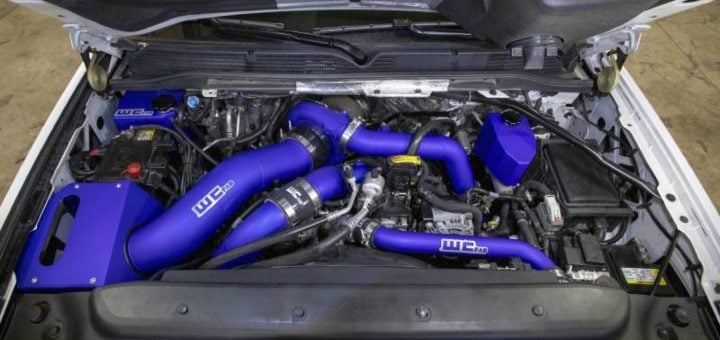Duramax LBZ Cold Air Intake Upgrade Guide

Meet Jake
Jake is a founder of 8020 Media and has been creating automotive content online since 2017. He has been the lead writer for Chevy Trucks and has transformed it from the old and outdated site it was into what it is today. Jake creates a ton of GM related content for the 8020 Media YouTube channel and specializes in Duramax and Vortec information but has a wealth of knowledge across all GM cars and engines. Jake believes the L5P is the best diesel on the market today.
When starting out with power modifications on an LBZ, a cold air intake is one of the best upgrades especially when used in conjunction with a tuner.
An intake upgrade will help supply the turbocharger with more air, improving turbo efficiency resulting in power gains up to 20whp and 50wtq. Additionally, it is a great upgrade for gas mileage as well with an intake increasing fuel economy by approx. 1-2 miles per gallon.
Having installed a lot of bolt-on mods on LBZ’s, I always recommend adding an intake system alongside a tuner as the best first place to start.
LBZ Intake Upgrade Benefits
- Power gains upwards of 20hp and 50tq *(not peak power gains)*
- 1-2mpg fuel economy improvements
- Faster turbo spool
- Increased throttle response
- 50%+ increases in air flow
I put an asterisk after the power gains because quoted gains can be misleading. In turbo diesel engines, the majority of power gains will be realized at lower RPM’s, or at the lower end of the power and torque curves. Peak horsepower and torque gains from a cold air intake usually fall within the 5-10whp range. However, many intakes will claim 20hp+ and 50tq+. While these gains are true, they are not peak gains. They are gains over the stock intake at low RPM’s.
Let’s look at this dyno chart from aFe as an example. Peak horsepower increases by 3whp and peak torque increases by 7wtq. However, if you look at the lower end of the curve, around the 2,000rpm mark, power gains are in excess of 20whp and 50wtq. Upgraded intakes are great for low-end power which is good for towing, acceleration, etc.

Power Constraints
If you plan on excessively modifying your Duramax LBZ, keep in mind that the engine and transmission are power constrained. As we wrote on our LBZ Common Problems guide, 600whp is the approximate mark where cracking pistons becomes common.
However, you’re guaranteed to break your stock transmission long before you crack a piston. While the Allison 1000 is a highly reliable powertrain, it does not fair well with modifications. The Allison 1000 transmission will generally need to be built and upgraded around the 400whp mark.
Open-Air vs. Closed-Box Intakes
As you look at my highlighted intake options below, you’ll notice two styles of intakes. Open-air intakes, in which the filter is open to the engine bay and closed-box styles where the filter is protected within a box.
Overall, the differences between the two are minimal. Open-air systems will flow additional air, closed systems will flow colder air. I prefer open intakes because the performance gains are better due to the increase airflow. The intercooler is good enough to make a difference of a degree or two not matter.
Whether open or closed, an upgraded intake will supply the engine with more air than the stock intake and that is the main purpose of upgrading.
Best LBZ Duramax Cold Air Intakes
I always prefer open intakes for the power gains – SDP’s 4″ open intake is the one I install the most on LBZ’s. Their intakes are best in quality and you can get them powdercoated in a ton of colors.
However, customers occasionally insist on a closed box intake and for those I always stick with the Banks Power system.
Both are great options. If you aren’t going for high power levels then a closed box intake is going to work just fine.
Best Open Intake: SDP 4″ Intake

The high quality finish and powdercoating options make SDP intakes my favorite option. They are a bit pricey at $400 considering it’s a piece of aluminum piping and a filter but it still comes in a bit cheaper than the Banks intake and the quality is actually worth the price.
They use S&B filters which are the best on the market so everything about this intake is just high quality.
Price: $399
Link: SDP 4″ LBZ Intake
Best Closed Intake: Banks Power Ram Air
Similar to the other two options, the Banks Power intake is another closed box system mounting directly in the OEM intakes spot. This intake actually sucks are from the bottom of the intake as well as the side. The thought process being that the air from the bottom is cooler than the air from the factory location.
This intake boasts a 57% increase in air flow over the OEM unit and has an increased outlet size of 7-1/8in. helping the intake deliver more air to the engine.
Price: $429
Link: Banks Power LBZ Ram Air Cold Air Intake
Combining an Intake with Tuning & More
At the beginning of this post, I called the intake a “building block to more power”. While a lot of folks say an intake is pointless with respect to peak power gains (which is sort of true) increased air flow is critical for high horsepower applications. While you can add a tune for mpg, the most common use of a tune is to increase power. On turbo vehicles, tunes do this by increasing the amount of boost or psi that the turbocharger is producing.
As boost or psi increases, the turbocharger has to compress more air. Compressing air to 30psi from 10psi requires 3x the amount of air. If you are running higher boost, you need more air entering into the engine to reduce lag and increase turbo efficiency. Additionally, the increased air flow also increases the pre-turbo air pressure, which improves turbo efficiency as the compressor wheel does not have to work as hard or spin as fast to create the increased boost pressure since the air is already more compressed.








